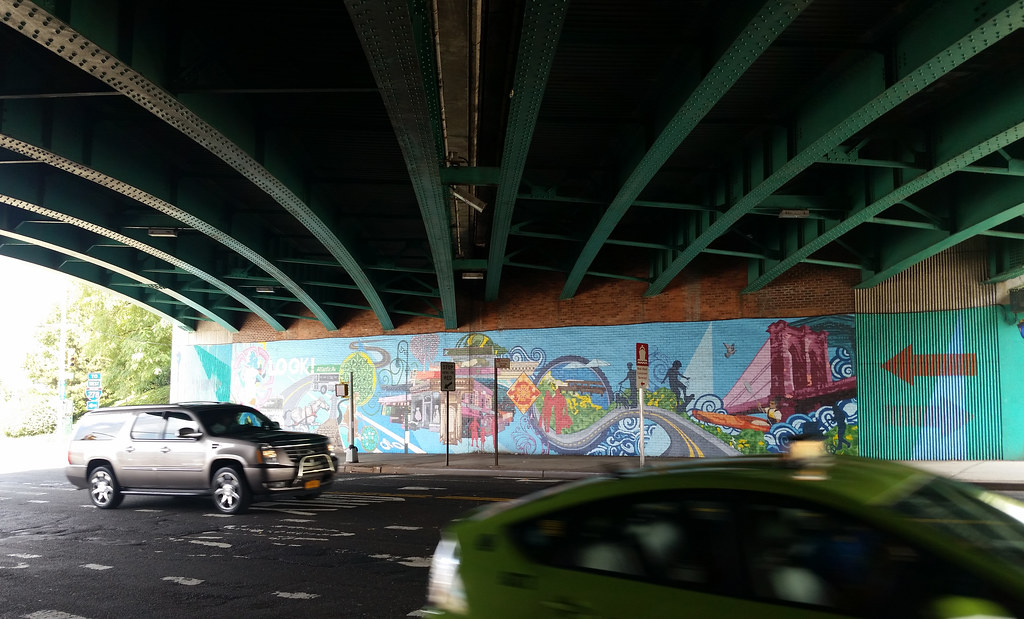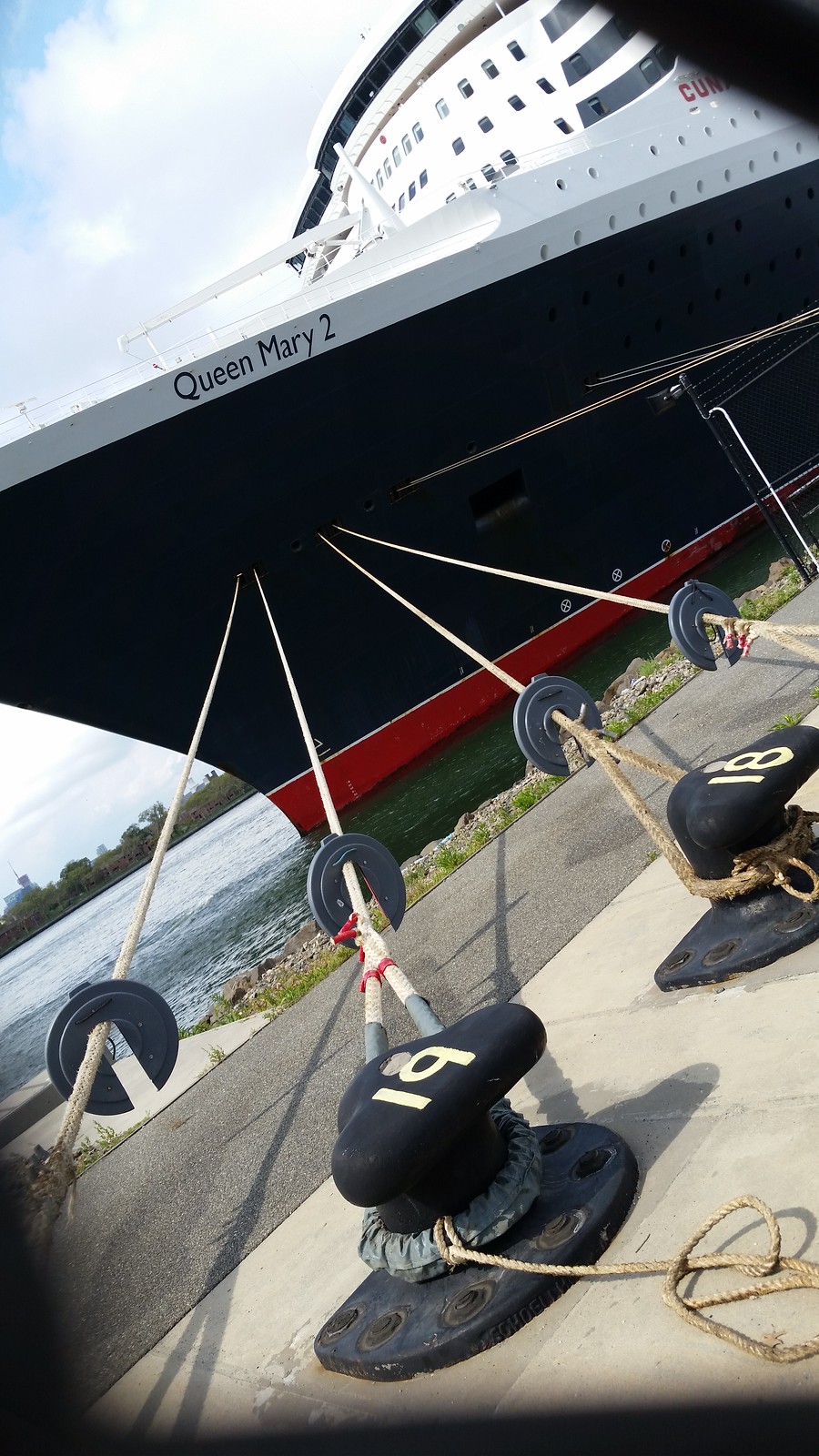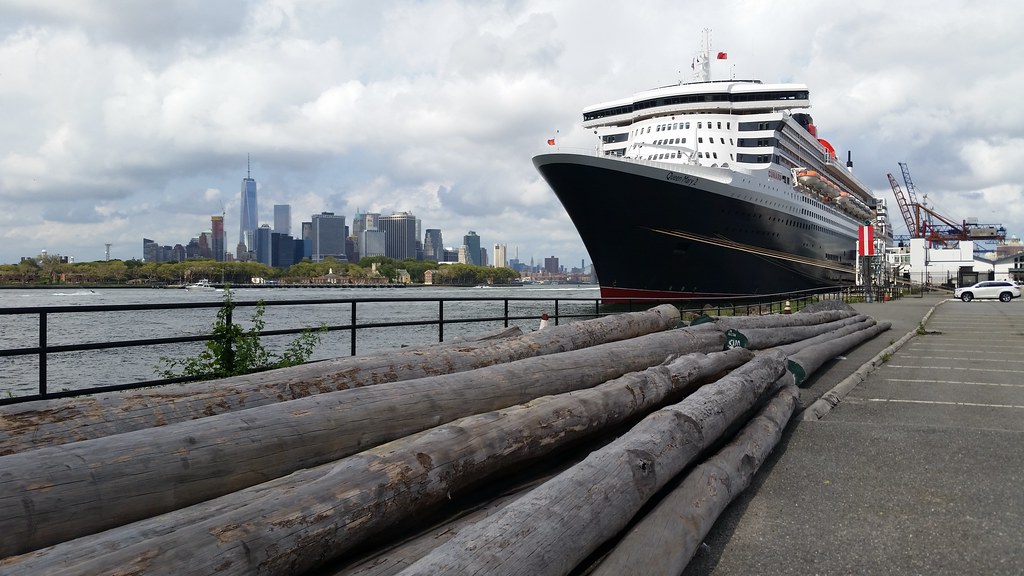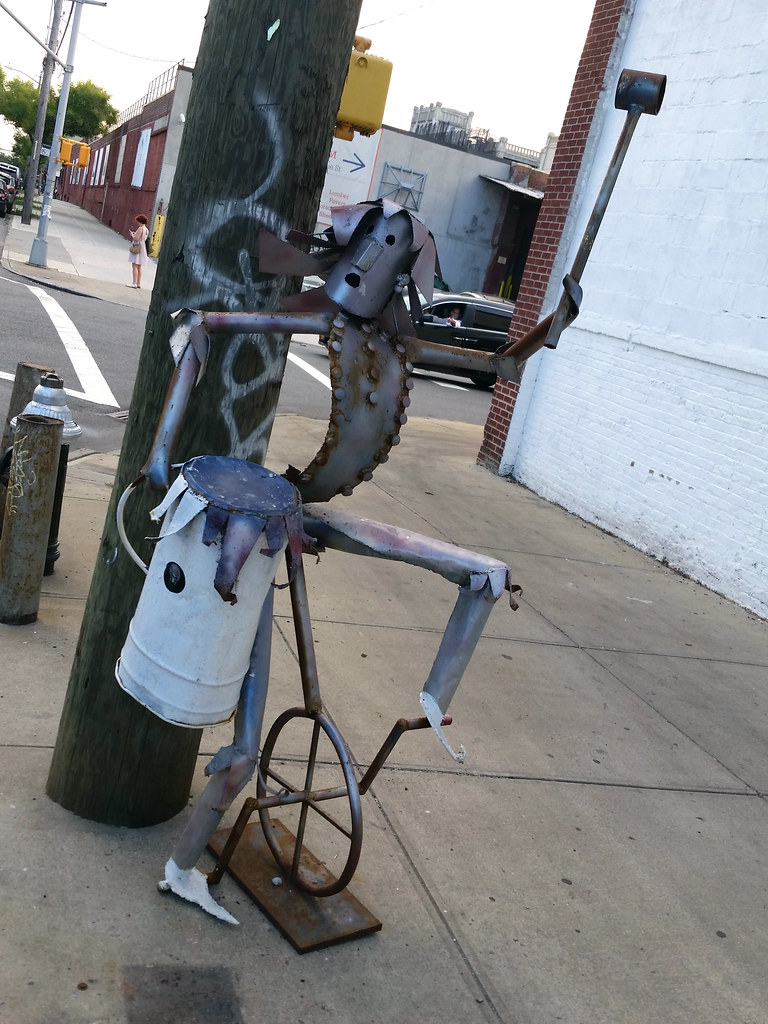

At left, you can see a little piece of Love Letter to Brooklyn.

Here's a photo from that day in 1931. Borough President/Honorary Stonemason Henry Hesterberg is the one holding the trowel.
This building is generally referred to as the Central Courts Building, despite the fact that it clearly calls itself the Central Court Building. You can see a couple of photos of its construction here.
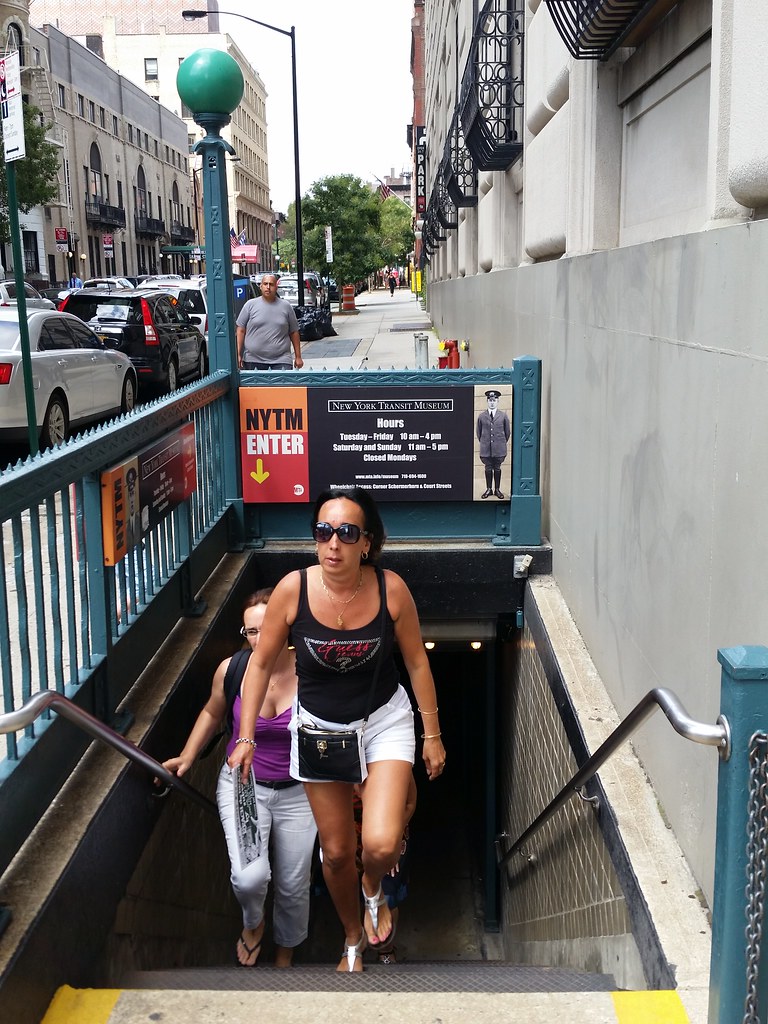
This is the entrance to the New York Transit Museum, which is located in the former Court Street subway station on the Fulton Street Line.

"The Society of Friends is well known for a dislike of ostentation and their buildings have traditionally portrayed that view with sound construction and unadorned facades. The Friends Meeting House at 110 Schermerhorn Street" — built in 1857 — "beautifully reflects the restrained character of Quaker architecture, and symbolizes the active presence of the Society in Brooklyn."

From the NY Times, Feb. 3, 2012:
When the Brooklyn House of Detention reopens next week after being closed since 2003, it may be the only city jail in America located down the block from a Barneys Co-op and a Trader Joe’s.On the occasion of the jail's reopening in 2012, the blog McBrooklyn published a list of "notorious escapes" by the facility's inmates over the years, including these two:
The building, a 1950s gray behemoth with screens covering its metal-framed windows, looms incongruously over one full block of Atlantic Avenue and rejoins a greatly changed neighborhood.
During the jail’s vacant period, six high-rise apartment buildings were constructed nearby. One boutique hotel now sits directly across from it on Smith Street, and 14 sleek, six-year-old, modern town houses sit next to handsome brownstones, just steps from an entryway covered in barbed wire where prisoners are unloaded when they arrive.
Some nearby residents in the Boerum Hill neighborhood expressed concerns about safety, while others, in typical New York fashion, worried about parking.
1) From Time magazine, June 16, 1980:
The short, beefy man strolled into the Brooklyn House of Detention, signed the visitors' log—"Michael Schwartz" —and asked to see his client. While the lawyer waited in a glass-enclosed meeting room on the first floor, a guard went to escort the prisoner down from his maximum-security cell on the tenth floor. The prisoner, clad in a jumpsuit and in need of a shave, greeted Schwartz, and the two began conferring in private. During their talk, the guards changed shifts; shortly thereafter, the new guards watched a clean-shaven man in a gray tweed suit sign out—"Michael Schwartz"—and stroll out of the prison and into thin air.(Jacobson was rearrested about six weeks later in the Los Angeles suburb of Manhattan Beach while talking on a payphone at a restaurant where he had ordered "the house specialty, fried zucchini with Parmesan cheese".)
The man in the gray suit was not Michael Schwartz but the jumpsuited prisoner, Howard ("Buddy") Jacobson, 49, successful horse trainer, real estate entrepreneur and convicted murderer. The man he left behind turned out not to be Michael Schwartz either, but Anthony DeRosa, 47, onetime bartender and a longtime pal of Jacobson's. When DeRosa himself tried to leave the prison, a guard asked him where his "client" had gone. Only then did prison officials belatedly sound the alert.
2) From the NY Times, July 10, 1991:
A murder suspect escaped from a maximum-security cell in a Brooklyn jail after making a dummy of wadded-up clothes and leaving it under the tattered woolen blanket on his cot, prison officials said yesterday.A follow-up story ran in the Times on August 31, 1991, under the headline "Escaped Killer Seized in Brooklyn, by Chance":
It was the second time that the 26-year-old inmate, Edward (Donny) White, had escaped from custody. The last time he did, he killed a man during a robbery, the police said.
The officials had no explanation for how he had escaped from his windowless fifth-floor cell at the Brooklyn House of Detention, 275 Atlantic Avenue in the Boerum Hill section. Thomas Antenen, a spokesman for the Department of Correction, said the lock on the cell door had not been jimmied and the bars had not been bent or broken. Correction officers speculated that he might have slipped into a garbage cart while he was outside the cell around dinnertime.
Mr. White's first escape, in July 1989, came when he hurled a typewriter at a detective at the 67th Precinct station house in the Flatbush section of Brooklyn while being questioned about another murder. He got away by jumping through a second-floor window and shinnying down a flagpole.
When police officers investigating the slaying of a bartender at a Second Avenue pub late Thursday knocked on the door of a Brooklyn apartment yesterday, the man in the bathrobe who answered turned out to be an escaped murderer who was one of the city's most wanted fugitives.
I also learned from McBrooklyn about a riot at the jail in 1970, one of four jailhouse riots in the city that began over a span of three days that October. The inmates, calling for "swifter trials, lower bail and more humane treatment", took a total of 26 guards and other employees hostage citywide, including 3 here in Brooklyn. Despite the lawlessness of their protests, their demands were met with support from some elected officials. Representative Adam Clayton Powell Jr., standing outside the jail in Long Island City where the riots began, told reporters, "Those cats upstairs are doing the right thing", and yelled up to the inmates, "Don't give up one inch. Keep up this fight!"
The Brooklyn riot lasted only 12 hours before the jail was retaken by force, but the melee caused what one prison official estimated to be $2 million in damage. Nonetheless, the acting warden at the overcrowded facility, which held 1,591 men in a building designed for 960, sympathized with the inmates, saying that "he did not blame the prisoners for harboring grievances. 'They didn't have anything against the prison itself or the guards,' he said. 'They don't like the court system. It takes too long. And I agree with them.' "
Good thing that's all fixed today!

This statue of St. Vincent de Paul (not the first such statue to occupy its perch) stands at the entrance to a branch of HeartShare St. Vincent's Services, a children's services provider. The building was completed in 1906 as the new, larger quarters of St. Vincent's Home for Boys — the predecessor of HeartShare St. Vincent's — which was founded in 1869 as a residence for "friendless and destitute boys". Here's how an 1879 Brooklyn Daily Eagle article described the mission of the home:
Its field of labor is among the boys of the street, the bootblacks and newsboys, and other lads who go to make up the large number of homeless and wretched children and youth who swarm in the thoroughfares of a great city. Some of them are the children of dissolute and wretched parents; others have no knowledge of what home or parent means. The aim is to rescue these children from the ways of poverty and vice, and to help them become self supporting and respectable members of society.A few years ago, a man named Ed Rohs published a memoir about his upbringing in five different Catholic institutional homes in the New York City area; you can read a partial account of his high school years at St. Vincent's, from 1961 to 1965, here.
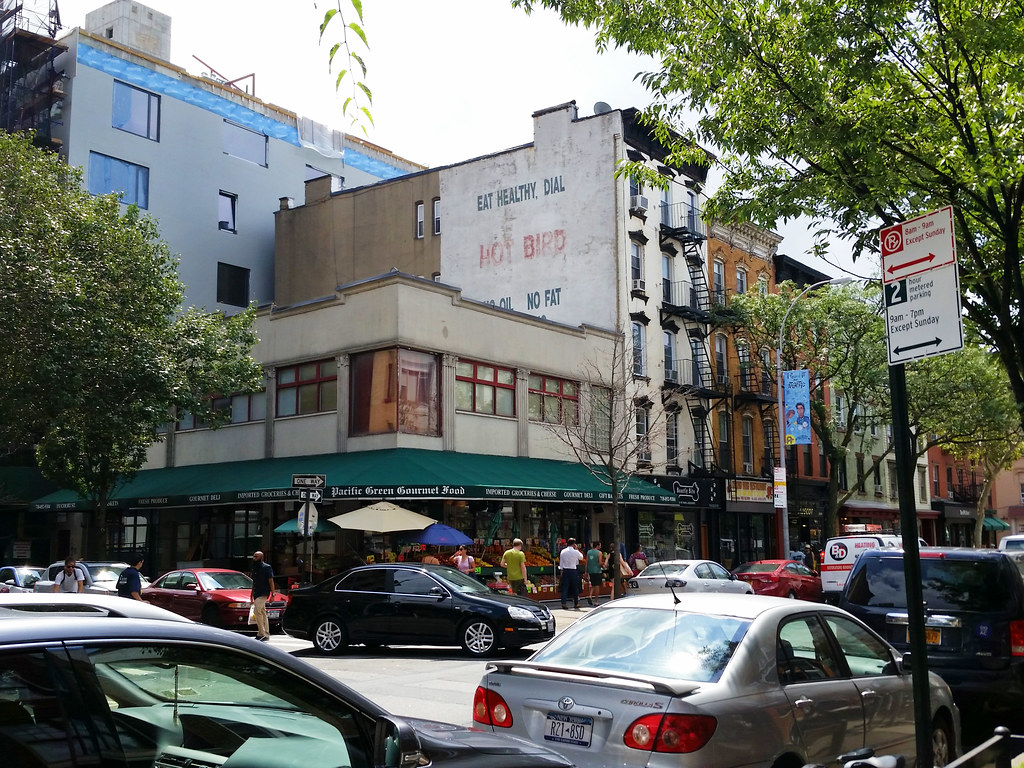
Hot Bird was a chicken restaurant with two locations in Brooklyn (665 Vanderbilt Avenue in Prospect Heights and 128 Montague Street in Brooklyn Heights). It went out of business perhaps 20 years ago, but has lingered in the local public consciousness thanks to its captivating name and enduring painted wall ads. As we've seen, the name lives on in a bar that opened beneath a Hot Bird ad on Atlantic Avenue in 2010.
I believe, however, that this is now the final surviving Hot Bird wall ad. (Here's an unobstructed look at it.) The other three, which were painted in black on yellow and offered directions to the original Prospect Heights Hot Bird, have vanished over the past few years. Two on Vanderbilt Avenue, including one particularly expansive one, were lost in early 2011 when the building they were painted on fell prey to Atlantic Yards. And the ad above the bar on Atlantic Avenue was painted over sometime in 2012 or 2013.
You'll notice that the ad above instructs you to "DIAL HOT BIRD". That's right — HOT BIRD is not only an instantly memorable restaurant name; it was also (with a 718 area code, I'm assuming) the restaurant's phone number! In 2008, the NY Times contacted a woman in Queens to whom the number had been reassigned. She claimed to still be getting calls asking for chicken at "all hours of the night".
In 1993, after the Brooklyn Heights Hot Bird opened, the Times listed the restaurant's number as (800) HOT-BIRD, and also mentioned that the proprietor, a former lawyer, wanted to open additional locations in Hoboken, New Jersey, and Charlotte, North Carolina. I haven't seen any evidence that those plans ever came to fruition, however.

This "interesting example of municipal architecture in the early Victorian style" (Street View) was built in 1888-89 as Public School 78. By 1969, it had become a religious school, the Louis Hirsch Memorial Jewish Education Center. It is now an apartment building, having been converted into co-ops in 1984. You can see photos of two different top-floor apartments here and here.

This former stable was built sometime in the mid-19th century. (The AIA Guide to New York City estimates 1840, while the city's Landmarks Preservation Commission says the late 1850s.) Here's how the place was described in an 1882 auction listing: "Two story and basement Philadelphia brick stable, 25x85; lot 100 feet deep; 12 stalls in basement, 6 stalls on first floor and large room for carriages, large harness closet; second story large loft and flat for coachman's family; water, gas and carriage wash".
In 1895, the building was remodeled and became Station No. 1 of the Fire Insurance Salvage Corps of Brooklyn. (Here's what the place looked like in those days.) The salvage corps was funded by local insurance companies, and its purpose was to minimize the property damage caused by fires in the area, hence reducing the amount the insurance companies would have to pay out in claims. The corps was sometimes able to extinguish small fires by itself, but its primary task was "to cover the goods in the burning building to protect them from injury by water, which generally causes more damage than the fire itself."
The men of Station No. 1 moved into a new home at 12 Dean Street in 1909. After coming under the control of the New York Fire Patrol in 1910, the company remained in its station on Dean Street until 2006, when the NYFP, the last surviving salvage corps in the nation, was finally disbanded. (The former station is now part of the Brooklyn Heights Montessori School, as we've previously learned.)
The building here on Pacific Street became an auto garage following the departure of the salvage corps in 1909. In 1910, ironically, the garage caught fire. By the time the blaze was put out, "eight expensive automobiles had been destroyed and the entire building gutted."
These days, 172 Pacific Street is a pretty snazzy abode (photos). It was featured in the movie Eat Pray Love, and is the kind of "rare and mythical" dwelling that "real estate dreams are made of", according to a broker who listed the place for $8 million in 2014. (It was eventually sold for $6.25 million, reportedly to Norah Jones.)
Now let's rewind to 1889, when the building was still being used for its original purpose: stabling horses. The coachman living here at the time was a middle-aged fellow named William Strong, and in April 1889 he was sentenced to a year in prison for harassing a young woman named Lizzie Jane Wood. To understand the scope of his harassment, we need to go back a few more years to when the two of them met.
(The following account is drawn from five different articles in The Brooklyn Daily Eagle. I'll link to them at the end.)
It was sometime in 1885 when Miss Wood, "a pretty, dark complexioned Irish girl, with bright eyes and rosy cheeks, plump and well dressed," was introduced to Mr. Strong, a red-faced man with a "bristling mustache" and "unevenly colored reddish hair stand[ing] straight out from his head," who "dresses plainly and roughly and seems to be a trifle out of joint, mentally."
Strong "began to be very attentive to Miss Wood, and at first she did not object to his suit", despite the fact that he was "not a man to attract a woman's fancy in appearance."
"She soon discovered, however, that he was of a very jealous disposition, and [would] become very angry and abusive if she displayed a preference for any other company. Finally she told him that he must not come to the house [where she lived and worked as a domestic] any more. He persisted, however, and followed her about wherever she went and circulated, she says, false stories concerning her."
Fed up with his abuse, she had him hauled into court in July 1886. "He apologized and was placed under bonds, which it was expected would have a tendency to make him conduct himself with more propriety."
Not a well-founded expectation, it turned out. He was "seen every night in the neighborhood watching the house where she lived. When she came out he would follow her. Miss Wood is a member of the choir of the Gospel Pavilion tent on Flatbush avenue. On one occasion Strong crowded in under the canvas near the choir platform and in a loud voice he denounced Miss Wood. . . . Several gentlemen who knew the circumstances promised to protect her whenever she went out at night. Strong began to annoy these gentlemen with stories about her and became so troublesome that the young lady again went before Justice Walsh and asked if something could not be done to keep him away from her friends. The Justice gave her little encouragement."
So she decided to take matters into her own hands. She procured a rawhide whip and waited for her tormentor to appear again. After he passed by her house one September evening in 1886, she chased after him with the whip. He "tried to defend himself but he was no match for the girl, and blow after blow in rapid succession fell upon his head and body. The street began to fill with boys, who enjoyed the fun immensely and kept crying out 'Lay it on him.' Miss Wood needed no advice. She did 'lay on' with a vengeance. The man saw that it would be useless to resist as all the crowd's sympathies were against him. He attempted to beat a retreat in the direction of Flatbush avenue but was hotly pursued by the girl who lashed him at every step. Blood ran from his face and his neck was badly cut. He ran into a cigar store at the corner of Flatbush and Carlton avenues for protection. She followed him and in a few moments he ran out and turned down Carlton avenue with the girl and an excited crowd at his heels. The whip continued to crack until he reached St. Mark's avenue, where he ran into Dr. Bunker's house, saying to the housemaid who opened the door, 'For God's sake let me in. She will kill me.' He piteously beseeched the girl to stop. With almost every word he received a blow for a reply, and with every blow the crowd cheered."
Speaking later to a reporter, Miss Wood said "I am satisfied with what I did and don't think he will trouble me any more. I wouldn't hurt a fly, but I am sorry my whip broke and my arm gave out, else I should have followed him still further. He got just what he deserved. My right arm is so lame to-day that I can hardly use it."
This corporal punishment may have been temporarily successful in chastening old William. As far as I can tell, his behavior toward Miss Wood was not deemed newsworthy again for a couple of years. In the meantime, two other unusual stories involving a William Strong appeared in the Daily Eagle. I can't be sure it was the same guy, but I'm betting it was.
Here's the first story, from November 1886: "Late last night William Strong cavorted around the Sands street entrance of the [Brooklyn] bridge declaring that he was pursued by a band of dynamiters who took him for an English spy. Ambulence Surgeon Cooke called it a case of delirium tremens and took the sufferer to the Cumberland street Hospital."
The second story, from December 1887, involves "a runaway horse attached to a coupe and driven by William Strong dash[ing] madly along the south roadway of the [Brooklyn] bridge". The horse, coupe, and driver "miraculously" exited the bridge without getting into an accident, but then "a collision of the coupe with the wheels of a coach, driven by William Dougherty, simultaneously tore a wheel from each of the vehicles, hurled the driver of the runaway team to the ground and freed his horse just in time to prevent a fatal accident, as Strong's legs had both become entangled in the spokes of the coupe wheel. The horse disappeared at full gallop up Sands street, and was followed shortly afterward by his driver, who quickly recovered from his fall. At last account he was being anxiously sought by Dougherty, who says his coach has been seriously damaged."
In February 1889, Strong was back in the news, and back in court, for harassing Miss Wood. During an encounter on the street a month earlier, he had "spat on her and hooted at her and followed her for two or three blocks. He had frequently stood opposite her house for hours, waiting for her to appear. Often he had scaled the fence and pulled open the basement shutters and gazed within until driven away. He had stopped her on the street and asked her to marry him and she had refused." The judge gave him the option of paying a $20 fine or serving 20 days in jail. He chose to do the time.
After his release, he got right back to business. He was arrested again in March after following Miss Wood and drunkenly "shouting abusive language after her." At the time, she was with a young man named Lewis Lewis (not a typo — at least not on my part). "A crowd had gathered when young Lewis turned and knocked Strong into the street with a blow from his fist. Strong then drew a knife but was arrested . . . before he had made any use of it."
Strong attempted to represent himself in court this time. He acted as though Miss Wood and Lewis were the ones on trial: "Your honor . . . I wish to make a brief statement regarding the arrest of these two persons for their unprovoked assault upon me in the public highway."
It didn't go well for him. "As soon as Strong left the stand the Court disposed of the case in an instant by imposing a sentence of one year in the Penitentiary, at which Strong surveyed the court room through his undamaged eye with aggrieved astonishment, and Miss Wood passed out into the street with her face wreathed in smiles."
(Here are links to the five Daily Eagle articles about the Strong-Wood affair: July 8, 1886; Sept. 11, 1886; Feb. 2, 1889; Mar. 25, 1889; Apr. 4, 1889.)
I searched the papers for subsequent articles about Mr. Strong, but couldn't find any. I did, however, discover this ridiculous item about a police officer of the same name in an 1891 Daily Eagle column entitled "Points About Policemen — What is Going On Among the Guardians of the Peace":
Detective Sergeant William Strong of the central office by taking off his beard has insulted himself most grievously. He owes an apology to his own personality, and if there is a spark of honor anywhere about him he will cast his razors, brush and cup into the deep sea and give his County Antrims and goatee another start in life. As now exhibited, he looks like a boy whose growth ought to be stopped by a special act, and no one would imagine that the fair fresh young face with the exterior of a cling stone peach was but a few short weeks ago thatched like the jowls of the ravenous pard. If he applied the scythe with the idea of effecting a disguise, he has succeeded most effectually, for a good deal of his time recently has been taken up in introducing himself to his most intimate friends, one of whom refused to pay him $1 he had borrowed two months before, until he produced his baptismal certificate.

The city's Landmarks Preservation Commission calls this "a handsome converted stable in the early Romanesque Revival style of the 1860s." A 1983 article in the NY Times says the stable was built in the 1830s and had its Romanesque facade added in 1870. Also from that Times article:
The owners of the house, Richard and Dorothy Turmail, said that between 1915 and 1920 it was used to house zebras when what is now the Ringling Brothers and Barnum & Bailey Circus was in town. "The animals were brought in by train," Mr. Turmail said. "They arrived at the Flatbush Terminal and walked up Atlantic Avenue. The building next door held the elephants."You can see some present-day photos of the house's interior here.
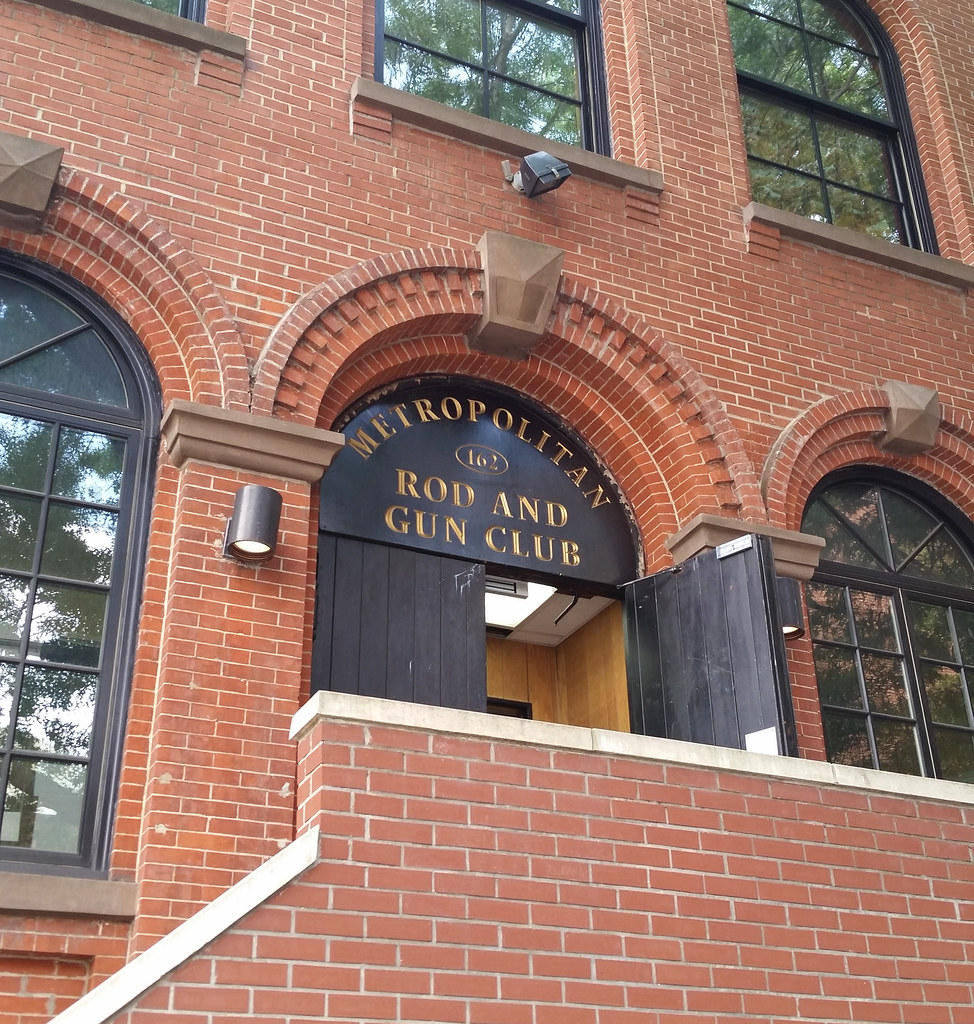
The Metropolitan Rod and Gun Club was founded in 1934. Its members purchased this building at 162 Pacific Street in 1939 and converted it into "a modern clubhouse . . . The basement became a model six-position fifty-foot rifle and pistol range . . . A second-floor archery range was added later."
In 1943, with civilian ammunition in short supply during World War II, the Brooklyn Daily Eagle reported that
The Nimrods of the Metropolitan Rod and Gun are not doing much talking these days. Their meetings are terse and businesslike. "Smack the game and spare the ammunition" is their motto.In other hunting news, a state conservation official asked the Daily Eagle in 1949 "to remind our Brooklyn duck hunters to send the duck stomachs to the Metropolitan Rod and Gun Club . . . As the food contents of these birds indicate their feeding habits, the commission can then help the hunter by supplying the proper food along their flight lines. They are particularly interested in the 'innards' of diving birds such as scaup and golden eyes."
With the necessity for making every shot count, the boys are out in the field looking twice before shooting. No ammunition is being wasted on sun spots or chimerical deer. Meat on the table is foremost in their minds.
For quite some time before the Rod 'n' Gun moved in, from the 1880s or 1890s until at least 1917, 162 Pacific was home to a ladies' underwear manufacturer. I don't know for certain that the same building was standing here then, but I suspect it was. An 1886 map shows a structure of the same general dimensions with two stories and a basement located on this lot. And given that the place "is designed in the early Romanesque Revival style", I'd guess it dates back at least as far as 1871, when the "new and beautiful" Coakley Hall at 162 Pacific Street, "comprising two large and commodious rooms, 25x100 feet, with supper room, for Balls, Political or Society meetings", was being advertised in the Daily Eagle.
Of all the goings-on at Coakley Hall over the years, two events in particular bear mentioning here. They both occurred in 1879, during the heyday of what was once "America's favorite spectator sport": long-distance competitive walking, known as pedestrianism.
In late January of that year, David Scanlon, "a Dublin boy, tall in stature, raw boned, and full of pluck and muscle", who had previously "come off first man in several amateur pedestrian contests", set out to walk 450 miles over six days on a 160-foot track laid out for him inside Coakley Hall. The short track, constrained by the dimensions of the building, would require him to walk 33 laps per mile — 14,850 laps overall — to reach his goal.
(If you click on the link in the paragraph above, you'll be taken to the Daily Eagle article that was the source of the information in that paragraph. If you scroll down to the bottom of the article, you'll find this announcement directly beneath it: "A sleigh worth about $30, and a quarter of beef, are held at the Thirteenth Precinct Station House, awaiting claims of the owners. The former was picked up last night in Bedford avenue, and the beef was found this morning in Flushing avenue.")
Gambling went hand in hand with pedestrianism, and $1,000 in bets were placed on Scanlon's walk. A judge was selected and a local athletic club agreed to keep a vigilant watch of the track at all hours to ensure the integrity of the results. If Scanlon made a good showing, there was interest in backing him against the likes of Dan O'Leary and Napoleon Campana in future matches, such as the upcoming race for the Astley belt at Gilmore's Garden (soon to become the first Madison Square Garden).
When his six days ran out, at 11 PM on Monday, January 27, Scanlon had walked 405 miles, leaving him 45 short of his goal. The Daily Eagle was quick to offer up excuses on his behalf, explaining that he "labored under the greatest possible disadvantages, the track was a miserable one, requiring thirty-three laps to the mile, and he had little or no coaching and absolutely no preliminary training for the big task . . . There is scarcely a doubt that Scanlon would have done his 450 miles had he been walking at Mozart Garden."
During Scanlon's walk, a policeman named Thomas Early found himself in hot water for leaving his post to join the crowd at Coakley Hall while he was supposed to be on duty. He was fined one day's pay for his transgression, and likely would have been given a more serious penalty if his superiors hadn't gone easy on him after learning that he had once been a "famous walker" himself.
After news of this incident spread, "challenges for a walking contest [began] pouring in daily upon him from various precincts." He accepted a proposal to compete against another officer, Hugh McGowan, in a 500-mile race. If the police higher-ups decided to allow the contest, Mr. Coakley promised to host it at his hall free of charge.
I don't think the Early-McGowan showdown ever happened, however, as I can only find one other article in which both of the officers' names appear. Published in March 1879, little more than a month after the piece about Early being fined and McGowan challenging him, the article is headlined "Inefficient Officers. — Getting Rid of Those Members of the Police Force Who Fail to Perform Duty in a Satisfactory Manner."
Early is mentioned only briefly in the article, for having been docked one day's pay for a "minor offense" (perhaps the Coakley Hall incident?). McGowan, on the other hand, wouldn't get off so lightly. He "was charged with failing to attend a fire on his post, and in order to excuse himself he made a false statement to the Board. That, together with his general neglect of duty and habitual use of intoxicating liquors, decided the Board to dispense with his services, and he was therefore dismissed from the force."
The second great bipedal event at Coakley Hall in 1879 began at half past ten on Friday night, February 23. 80-year-old Bartholomew O'Donnell, "the octogenarian pedestrian", a "hale and hearty" working man and native of Ireland, set out to walk 75 miles in 24 hours. But, like Scanlon before him, he came up short. At 8:45 on Saturday evening, having walked 62 miles and with insufficient time left to complete the remaining 13, he reluctantly called it quits at the insistence of his friends, according to the Daily Eagle. The paper reported that his failure was more than just an athletic disappointment:
The old man . . . has worked hard for a living since he came to this country, over 60 years ago. Although strictly temperate and industrious in his habits, he never made [much] headway in securing a competence, and he looked forward anxiously to his big walk as a means for providing him with a few dollars to carry him through the Winter, without being obliged to do whatever odd jobs he could pick up. In Summer time he is a constant visitor to picnics, where he engages in athletic sports and dancing, but in Winter he has to depend for his support on being employed to shovel snow or put in coal. For the old man's sake it is to be regretted that he did not meet with more success in his last undertaking, for the receipts will fall short of the outlay.(The record for distance covered in 24 hours by someone 80 or older is 94.63 miles, set in 2013 by 80-year-old Geoff Oliver at a Self-Transcendence 24-hour race in London.)
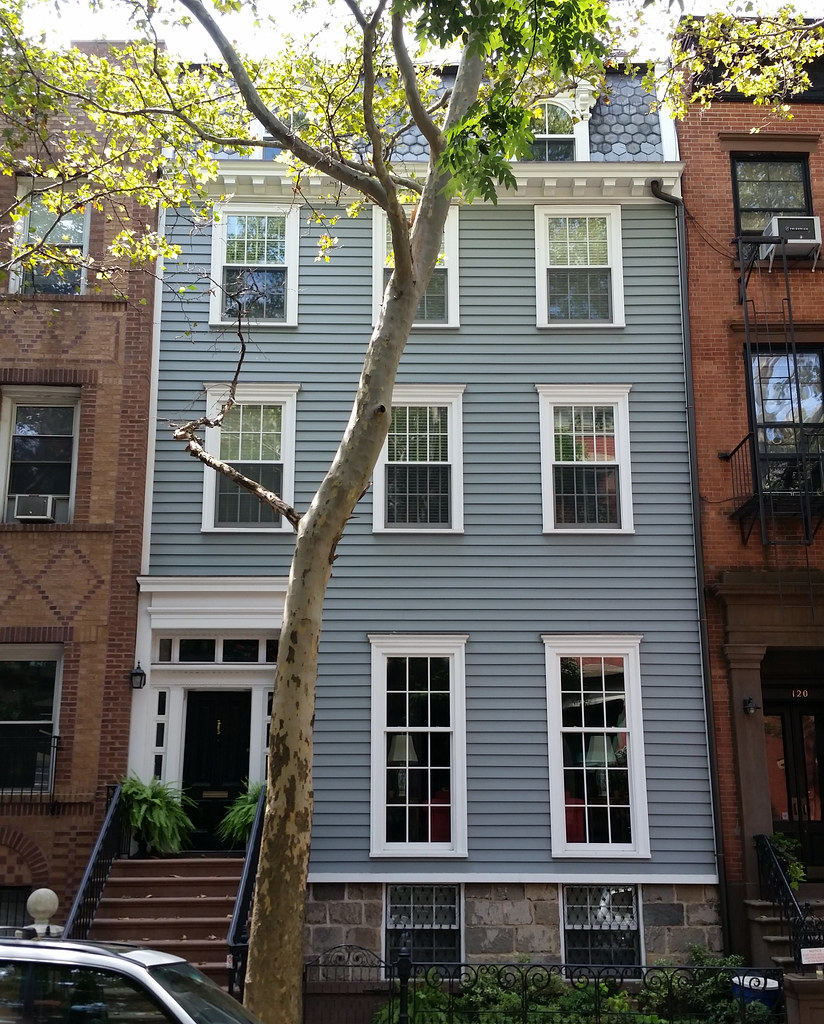
According to the city's Landmarks Preservation Commission, this is the oldest house in the Cobble Hill Historic District, "built in or shortly before 1833, in the Greek Revival style". The mansard roof was reportedly tacked on in the 1860s (perhaps during the "mansard mania of 1868 to 1873"), and the house's original clapboard siding was covered with faux-brownstone stucco in 1922. It was only in 2013 that the stucco was removed and the rotted clapboards replaced with new ones.
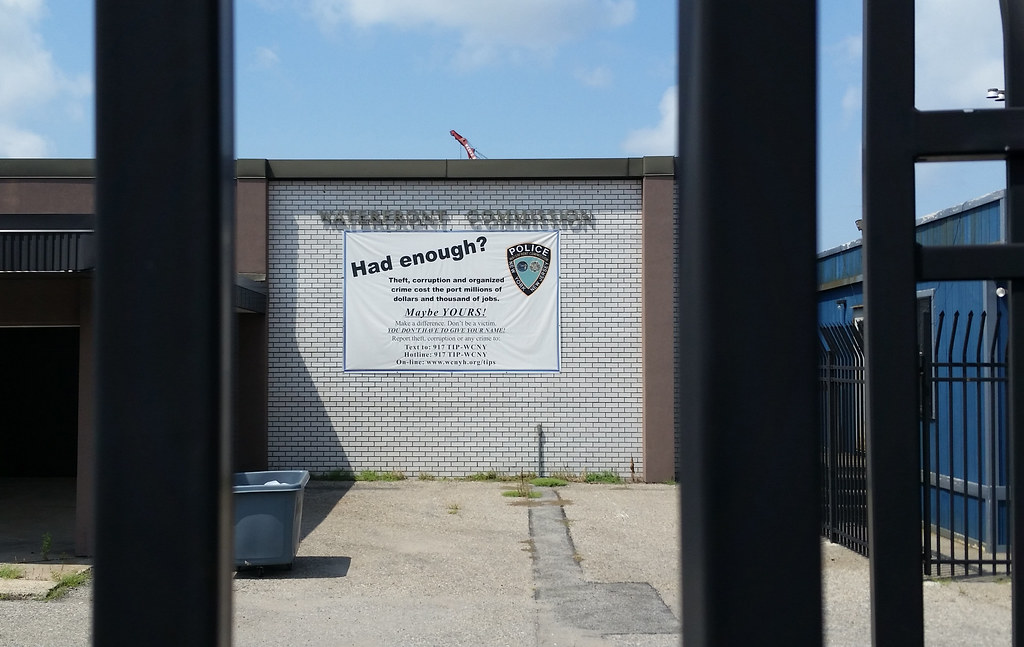
Theft, corruption and organized
crime cost the port millions of
dollars and thousand [sic] of jobs.
Maybe YOURS!
Make a difference. Don't be a victim.
YOU DON'T HAVE TO GIVE YOUR NAME!
Report theft, corruption or any crime
This sign hangs outside the Brooklyn office of the Waterfront Commission police. The Waterfront Commission was established in 1953 to combat organized crime on the docks of New York Harbor, but by the time of a 2007-08 investigation, which led to the ouster of "virtually the entire executive staff", the commission had become "its own bastion of lawlessness, employing some of the same corrupt, self-serving methods as the gangsters it was supposed to pursue".
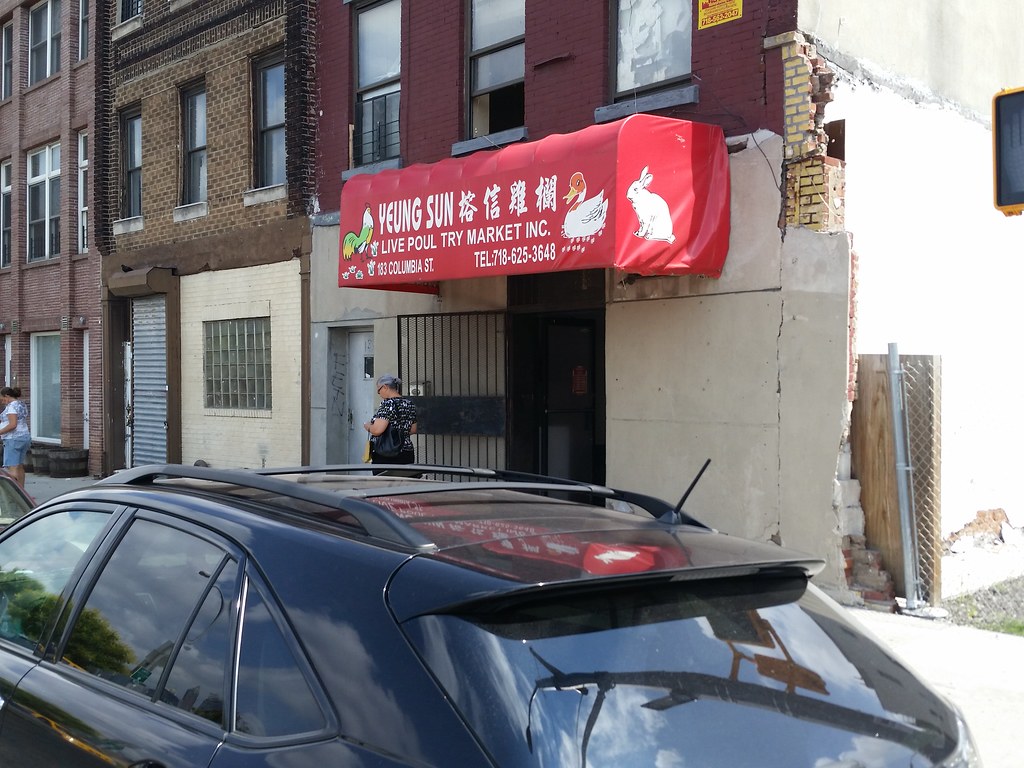
From the NY Times, Dec. 30, 2011:
Some of the neighbors had been heard to express the wish over the years that a divine hand would smite Yeung Sun Live Poultry.The drilling of a tunnel for a new wastewater force main caused the partial collapse of the building that stood immediately to the right of the Yeung Sun storefront above. The one-story structure, which housed Yeung Sun's walk-in freezer and other equipment, had to be demolished as a result of the collapse, and the lot where it stood remains vacant to this day. (A jagged brick remnant of the building's front wall can be seen above, still attached to the side of the storefront.) It seemed like the end might be nigh for the slaughterhouse in the wake of the collapse, but Yeung Sun managed to hang on and stay in business, dashing the sweet-scented dreams of many of its neighbors.
Clucking chickens went into its storefront. Dead ones came out, bound for Chinatown restaurants. So did blood, and entrails, and putrid odors that wafted past the fancy lofts and dark-wood bars of an up-and-coming neighborhood near the Brooklyn waterfront, a place that prefers its industrial grit to look a bit more picturesque and smell a tad less gritty.
So it was with a mix of schadenfreude and guilt that locals greeted the news that the poultry shop had been felled by a freak accident late last week, as city workers dug a tunnel to remedy an even more celebrated stench — that of the Gowanus Canal.
I came across this stratified anthropomorphic collage, part of Dustin Yellin's Psychogeographies series, at Pioneer Works, "a cultural center dedicated to experimentation, education and production across disciplines." Founded here in Red Hook in 2012 by Mr. Yellin, Pioneer Works occupies a large brick structure likely built (or perhaps rebuilt) by Pioneer Iron Works around 1882 following a fire that destroyed the property the previous year.

This structure stands in the garden at Pioneer Works. The second floor is home to a recording studio and a number of what appear to be electric hairbrushes.
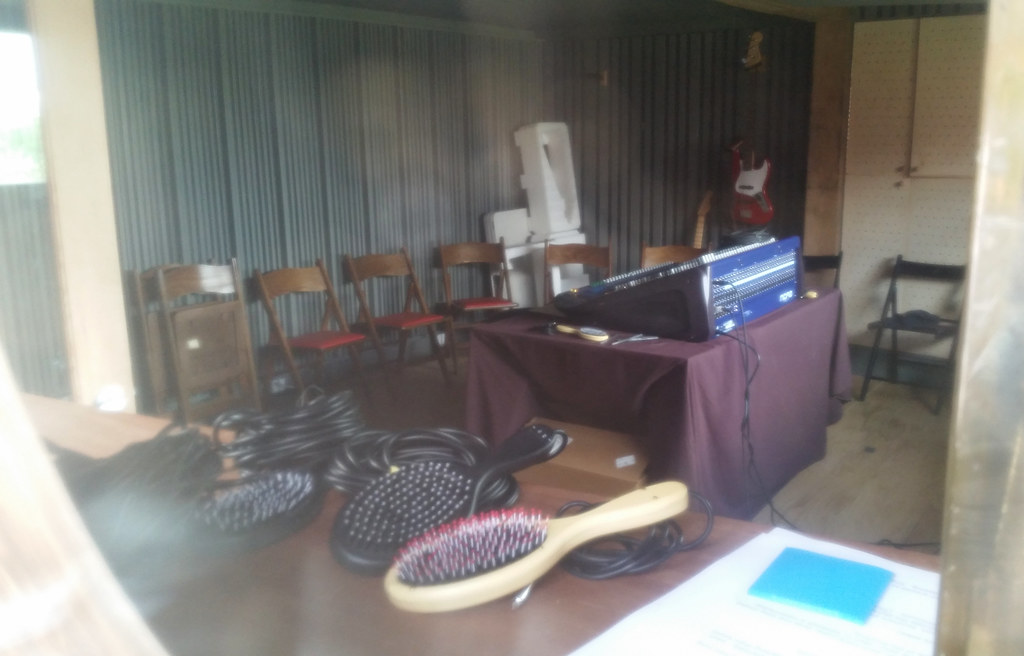
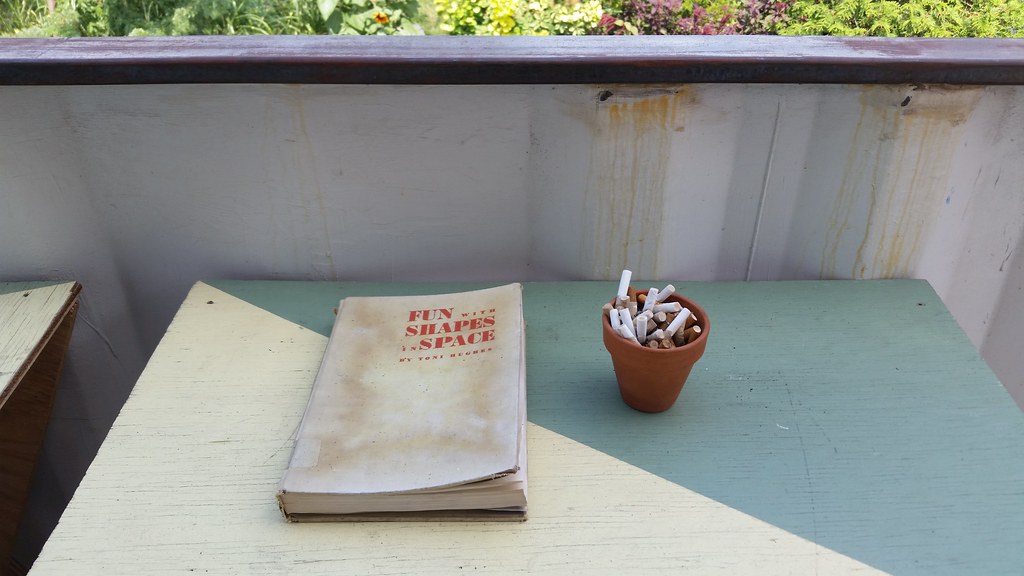

Fun with Shapes in Space, published in 1960: "How to make 3-dimensional 'things' useful in home, school and community recreation. Including techniques of string construction in addition to other skills and materials."

as seen from the top of the shipping container tower

From atop the shipping container tower at Pioneer Works, we can see the Queen Mary 2, in port at the Brooklyn Cruise Terminal, and the skyscrapers of Lower Manhattan.



When it was completed in 2003, the Queen Mary 2 was the world's largest passenger ship. It has since been surpassed in size by a number of other cruise ships, but it's still the largest ocean liner ever built. (Unlike the QM2, a normal cruise ship is not designed to make transoceanic voyages.)
The QM2 is so tall that it had to be built with a shorter-than-usual funnel so it would be able to pass beneath the Verrazano-Narrows Bridge and enter New York Harbor. It's still a tight fit (video); at high tide, the ship has only 13 feet of clearance beneath the Verrazano.


There's not much in the way of greenery at the Brooklyn Cruise Terminal — just three perfunctory little planted areas surrounded by acres of pavement. But growing in these tiny patches of dirt are some tomatoes and what look like acorn squash (as well as lots of purslane and lamb's quarters).
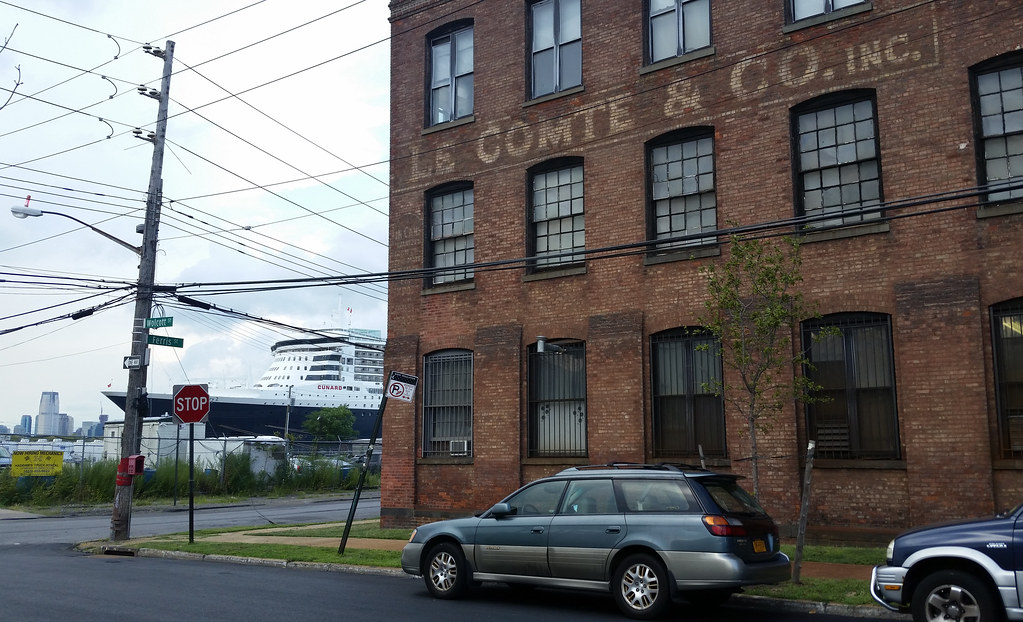
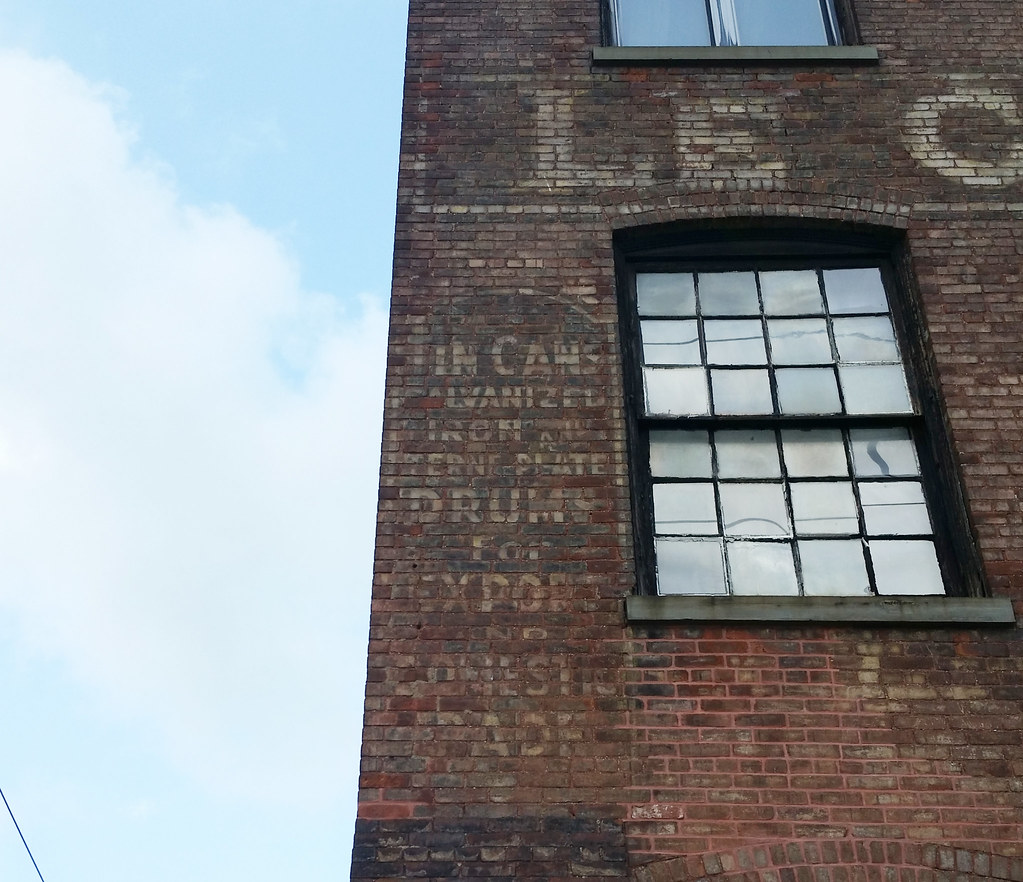
Tin Cans, Galvanized Iron and Terne Plate Drums for Export and Domestic Trade
Founded in 1903, Le Comte & Company manufactured "a specialty general line of metal cans and metal waste baskets". The company apparently managed to stay in business until 1993, though it had long since left Red Hook at that point.
This building is part of a late-19th-century industrial complex that was in pretty rough shape when it was bought in 1998 by its current owner, a man named... Rhett Butler. Mr. Butler, who moved with his wife into the top floor of the building above, spent years restoring the complex to house production studios for the "meticulously crafted, often jewel-like hinges, locks, levers, escutcheons, pulls and the like" that have made his business, E.R. Butler & Company, "one of the most prestigious hardware companies in the world". He also built an impressive-looking walled garden on the property and installed a rooftop hot tub (which I believe you can see here).

I took this photo outside Dell’s Maraschino Cherries in Red Hook. Dell's was in the news a few years ago when a couple of local beekeepers discovered that their bees' honey, not to mention their bees' stomachs, had turned "an alarming shade of Robitussin" — if you can even use the word "honey" to describe "a red concoction that tasted metallic and then overly sweet". Meanwhile, unusually large numbers of bees had been seen buzzing around the cherry factory...
Dell's made headlines again more recently, in a much more tragic fashion, when the head of the company shot and killed himself after a team of investigators, visiting the factory on an unrelated matter, began to suspect he was secretly growing marijuana here. As it turns out, he was, big time. His basement farm was "the largest indoor marijuana growing operation any of the investigators had ever seen in New York City".
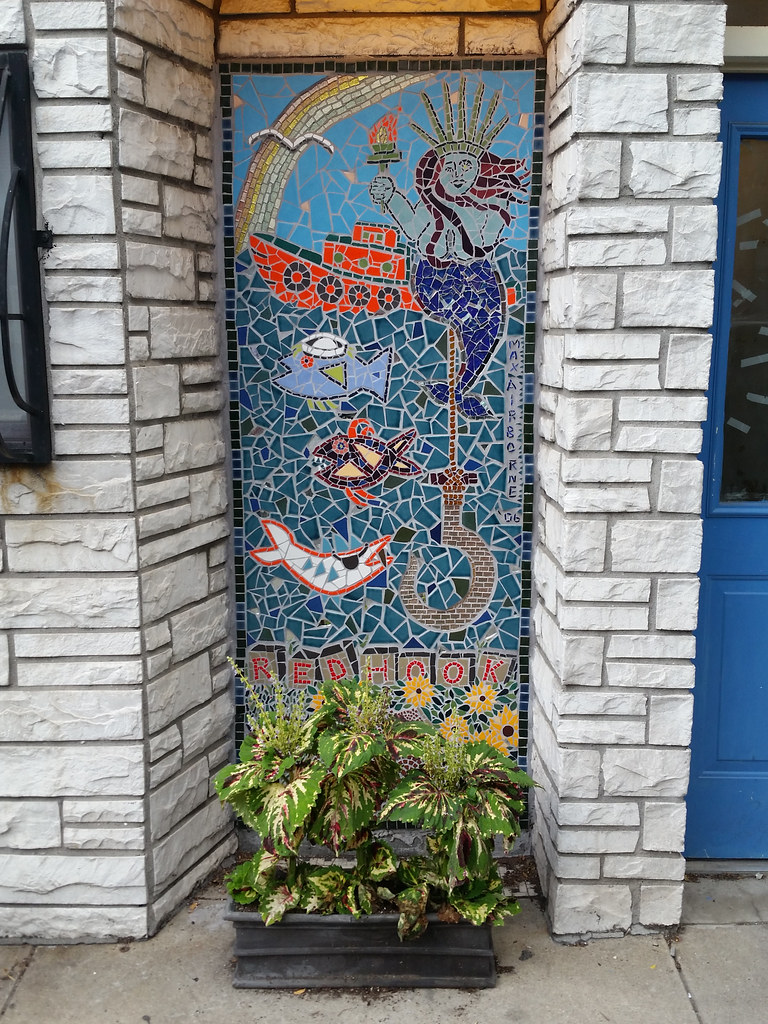
This piece was installed in 2006 (photos) by the artist and self-described "fat dyke" Max Airborne, a fat activist and disability justice activist.
May we learn to love ourselves, and may we show each other how. May we be free.
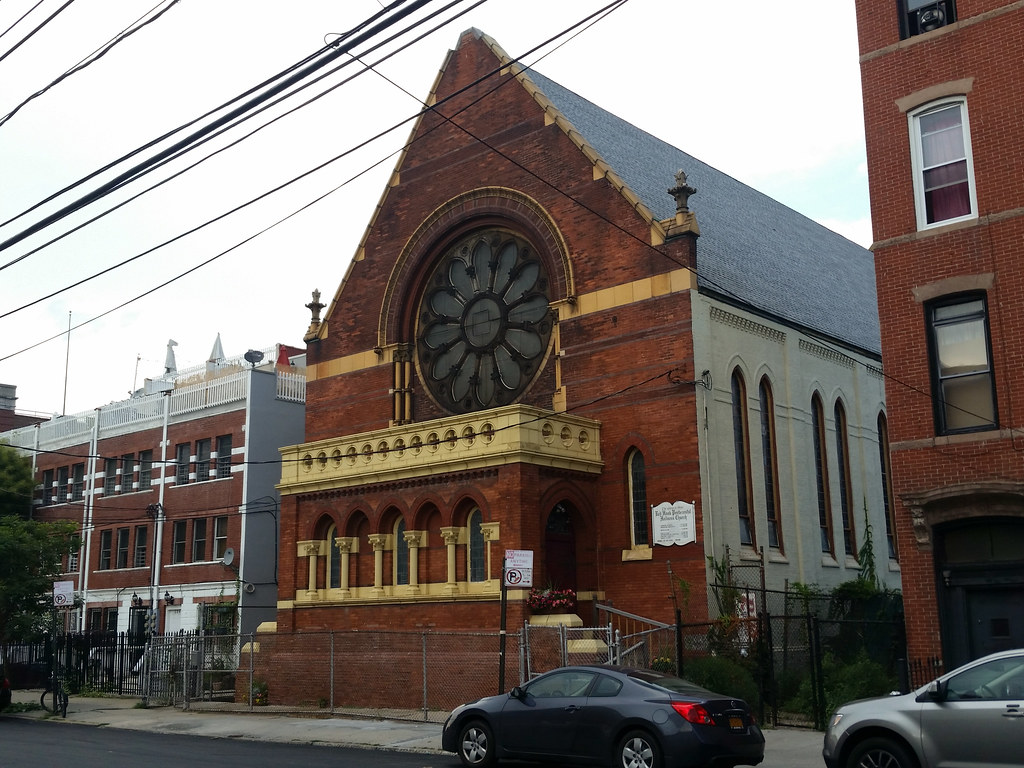
Built 1899-1900
UPDATE: The church is apparently for sale. Check out the online listing for photos of the interior.
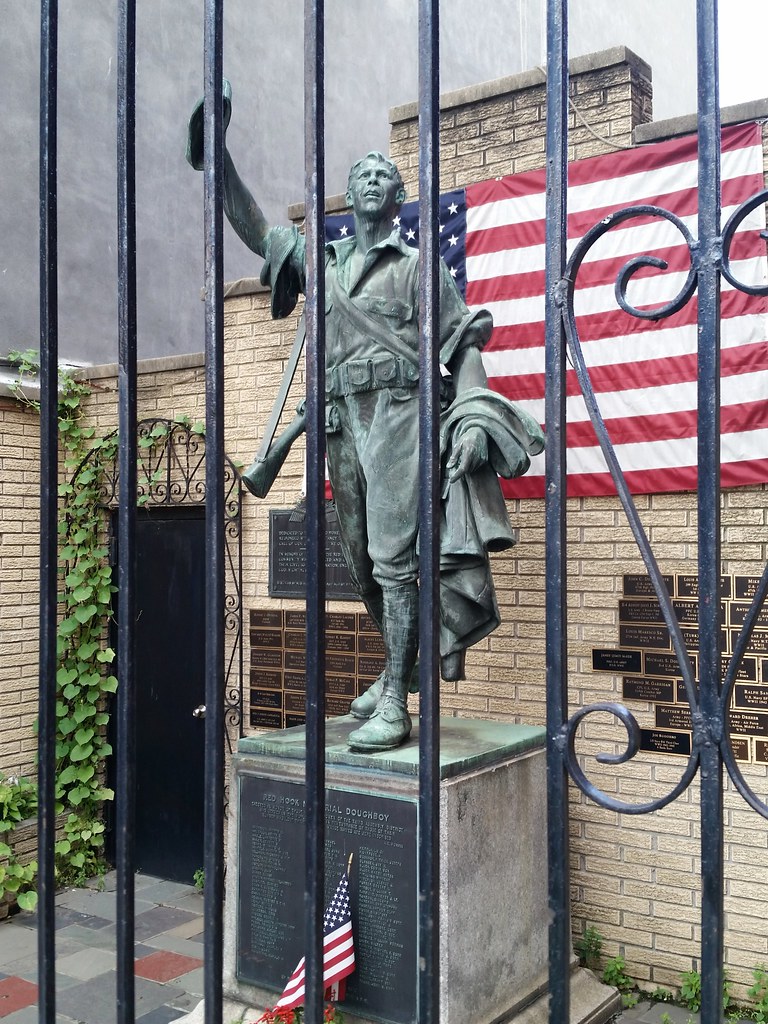
This World War I memorial was dedicated in 1921 in nearby Coffey Park. It was moved here, outside VFW Post 5195, around 1972 after having been vandalized in the park on multiple occasions. One such incident occurred in 1948, when the doughboy "was torn down by a gang of about 40 young toughs . . . [who] shoved at the statue until it broke off just above the ankles and toppled face down to the ground".
The doughboy was sculpted by Augustus Lukeman, who was later hired to carve what would become the country's largest Confederate monument on the side of Stone Mountain, the Georgia landmark where the modern Ku Klux Klan was born. (Lukeman took over at Stone Mountain after the departure of Gutzon Borglum, who would go on to carve Mount Rushmore.)
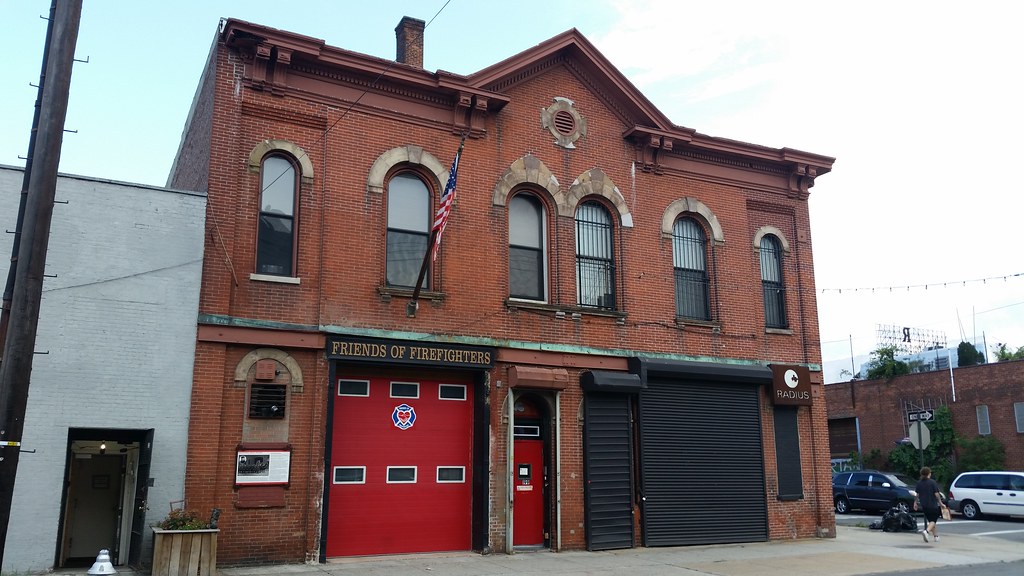
Now home to Friends of Firefighters, this building was an active firehouse from 1872 to 1960.
(That's the R of E.J. TRUM in the background.)
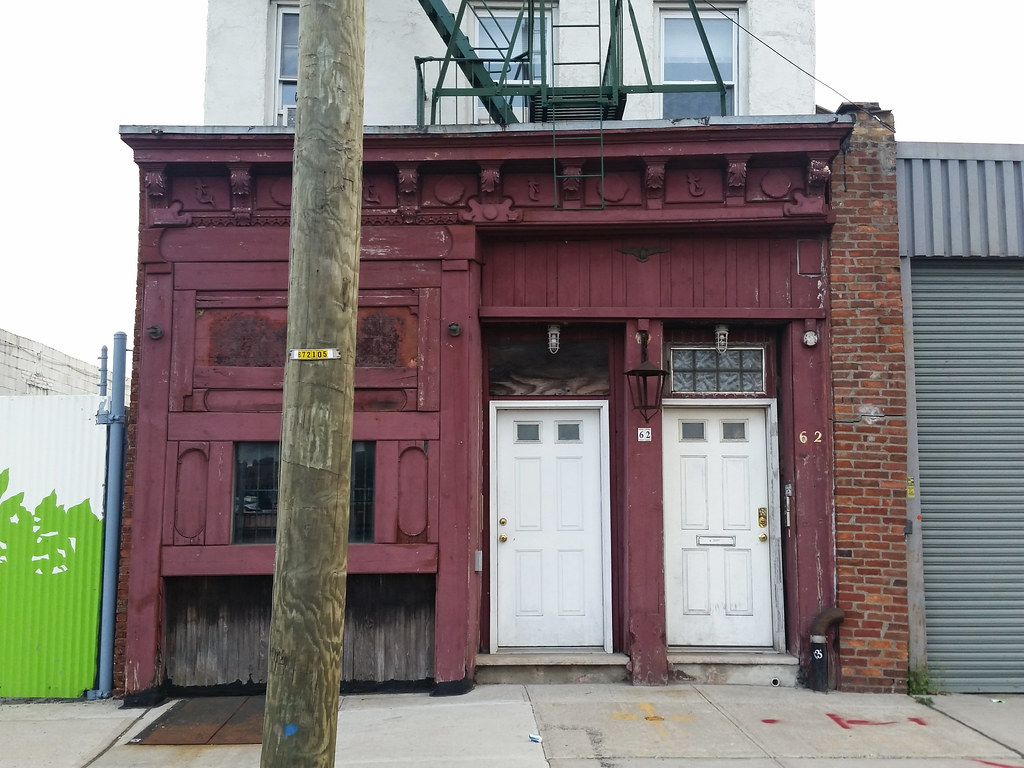
Zoom in to check out the mermaids and (what I'm guessing were once identifiable as) seashells floating between the corbels at the top of the first-floor facade.
This building is known locally for the OBAMA❤ mural painted on its upper stories.
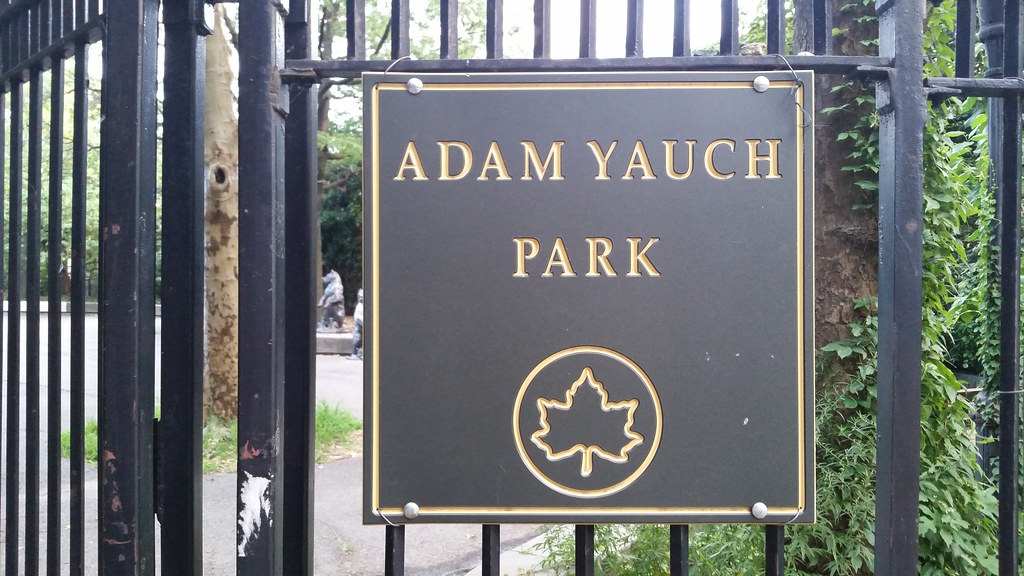
A year after his death, this park was renamed for the late, great member of the Beastie Boys, who grew up playing here. The park's seemingly mundane former name, Palmetto Playground, was actually one of Henry Stern's strangest appellative concoctions. As told by the Parks Department:
Palmetto Playground’s nomenclature was inspired by the names of the surrounding streets: Atlantic Avenue, Columbia Place, and State Street. Columbia is the capitol of South Carolina, an Atlantic state, and the state tree is the Cabbage Palmetto, hence, Palmetto Playground.(There is at least one trace of Mr. Stern's personality still remaining in the park, however: those dancing bear statues in the background.)
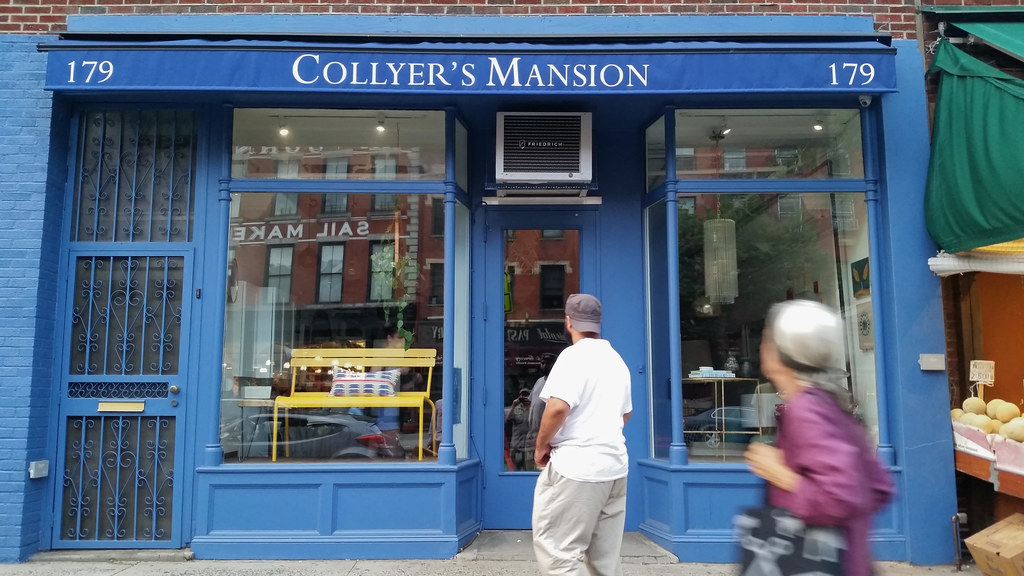
Homer and Langley Collyer were NYC's most famous hoarders. The reclusive brothers, rumored to be quite wealthy, lived out their lives in a jam-packed Harlem row house "honeycombed with tunnel-like passageways through the piles of newspapers and debris."
One day in 1947, while bringing food to Homer, who had been blind and paralyzed for several years at that point, Langley accidentally triggered one of the many booby traps he had set inside the house, causing a mountain of rubble to collapse and suffocate him. Left alone with nothing to eat, Homer died some days later. Responding to a call, the police discovered Homer's body on March 21. Because the house was so crammed full of junk, they were unaware that Langley lay just ten feet away from his brother. His body wasn't found until April 8.
The Fire Department still uses the term "Collyers' Mansion" to refer to a dangerously overstuffed dwelling. The owners of this home goods shop adopted the name for their original Ditmas Park location, "a tiny store . . . filled with stuff" arranged "like Tetris".
(In the window at left, you can see a reflection of what once was a painted sign for John Curtin Inc., Sail Makers & Canvas Goods — and what now is essentially decor for an Urban Outfitters store, helping to convince its customers that they're enjoying an authentically vintage shopping experience.)

